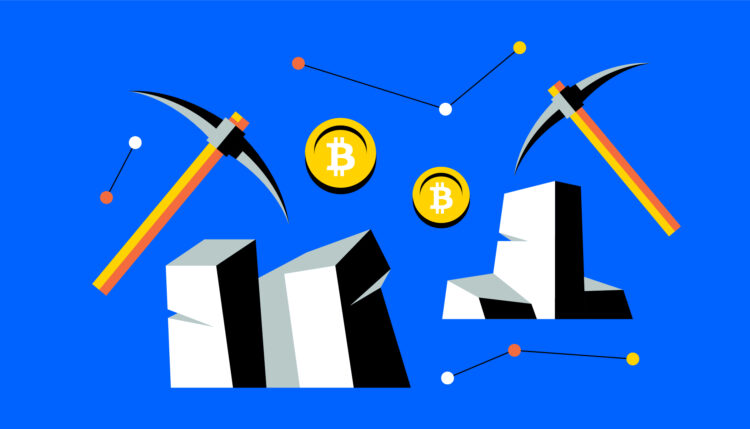Often hailed as future money, crypto has taken the financial world by storm. Unlike traditional currencies governed by central entities, it operates on blockchain technology, ensuring no single institution has control. The decentralization of crypto offers unparalleled financial freedom, especially in regions with unstable traditional currencies.
Beyond its use as a medium of exchange, cryptocurrency’s rise, exemplified by Bitcoin and others, has transformed it into a lucrative investment avenue. From lending and trading to dividends and airdrops, the opportunities are many – whether you’re a seasoned investor or a newbie. In this article, we’ll take a closer look at the various ways you can capitalize on this digital gold rush.
Page Contents
Ways to Make Money With Cryptocurrency
The cryptocurrency world offers many investment opportunities, each with unique potential and risk profiles.
Investing in Cryptocurrency

Source: entrepreneur.com
Crypto investors directly participate in the growth of the digital economy: they purchase coins like BTC or ETH, or invest in crypto index funds that diversify holdings across multiple coins. It requires a strategic approach, as the crypto market is way more volatile than the traditional one, and also often underregulated and easily influenced by tech innovation and simply social media news. To avoid those pitfalls, experienced crypto investors usually choose one or several of the basic crypto investing strategies:
Long-term Holding (HODLing)
This strategy involves buying and holding crypto for an extended period of time, regardless of short-term market fluctuations.
Diversification
Similar to traditional investment portfolios, diversifying crypto holdings can mitigate risk. Instead of investing in just one coin, investors spread their capital across multiple assets.
Swing Trading
This involves taking advantage of short-term price movements in the market. Investors buy during dips and sell when the price rises.
Dollar Cost Averaging (DCA)
With DCA, investors allocate a fixed amount of money to buy crypto at regular intervals, regardless of its price.
Fundamental Analysis

Source: brookings.edu
Investors analyze the underlying factors of an asset – its technology, team, use case, and market demand – to make informed decisions about its potential long-term value.
Given the volatility of the market, it is important to have a tool at your fingertips to track cryptocurrency rates and exchange offers. Monetory.io provides users with data on P2P exchange offers from exchanges, platforms and local exchangers. Success in the cryptocurrency market depends on a combination of strategic planning, continuous learning, and using the right tools – one of which is free coin live watch service by Monetory.
Lending Cryptocurrency
Lending crypto allows users to earn interest on their holdings – and make money on crypto. At its core, the process involves providing your crypto assets as a loan to another individual or platform, and in return, you earn interest over a specified period. Much like traditional banking, where you deposit money and earn interest, in the crypto domain, you deposit your digital assets to earn a return.
The mechanics of crypto lending often happens on specialized platforms – crypto lending platforms – or within DeFi protocols. Users deposit their crypto assets into a smart contract or a lending pool. Borrowers, on the other hand, collateralize their loans: they provide another crypto as security for the borrowed amount. This collateral acts as a safety measure to ensure you get your money back in case the borrower defaults.
Cryptocurrency Trading
You must have heard of this one. Crypto trading has been called names and labeled everything from “gambling” to “the most effective way to earn money in the XXI century”. Be that as it may, crypto trading is a huge industry, and millions trade cryptocurrency and make profit around the world.
Trading has risen to prominence as a viable short-term money-making strategy for many, leveraging the volatility and liquidity of the crypto market. Unlike traditional HODLing that we talked about earlier, trading focuses on short-term price movements, aiming to buy low and sell high in relatively short intervals (from minutes to days or weeks).
The process involves meticulous analysis of market data to make informed decisions, most prominent being technical and fundamental analysis. The former involves reading and interpreting price charts, using various indicators to predict future price movements based on historical patterns.
The latter delves into the underlying factors that might influence an asset’s price – e.g., tech developments, regulatory news, or macroeconomic factors.
A successful trader often has a blend of both analytical skills, combined with a strong emotional discipline to prevent rash decisions driven by fear or greed. These help them a lot to make money trading crypto.
Mining

Source: coinbase.com
Now, let’s get back to basics. Mining, the backbone of blockchain, is one of the earliest methods used by crypto enthusiasts to make a buck.
Mining involves leveraging computational power to solve complex mathematical problems – and thus to validate and secure transactions on a blockchain. Once these problems are solved, new blocks are added to the blockchain, and miners are rewarded with newly minted coins for their efforts.
There are two primary approaches to mining: hardware and cloud mining. Hardware mining requires a significant investment in specialized equipment called ASICs or high-powered GPUs). These machines are specifically designed for the heavy computational demands of mining operations.
On the flip side, cloud mining is a way for the crypto crowd to participate in the process without directly owning or maintaining any hardware. Instead, they lease or buy hashing power from larger data centers that run mining operations. Awesome, right? This is literally making coins out of the thin air.
Staking
Another way to earn on crypto just by having it (besides lending) is staking. It involves holding and locking up a certain amount of crypto in a wallet to support the operations of a blockchain network.
Unlike the energy-intensive process of mining, staking is a more energy-efficient method aligned with the Proof-of-Stake algorithm and its variants. In PoS-based blockchains, validators are chosen to create new blocks based on the number of coins they hold and are willing to stake (or lock up) as collateral.
This means that the more crypto one is willing to stake, the higher the chance of being chosen as a validator and earning rewards. Staking not only provides an avenue for passive income – it also helps in enhancing the security and efficiency of the blockchain. Earning crypto and being a good guy? Yes, please!
Traditional Buy and Hold
The “buy’n’hold” approach is also termed as HODLing in the crypto community. It is a long-term investment strategy borrowed from traditional stock market investing. The underlying principle is straightforward: purchase an asset and hold onto it for an extended period, regardless of short-term market fluctuations, with the expectation that its value will increase over time.
There is an important extension of this approach – “buy the dip” strategy, which emphasizes the purchase of assets during market downturns or when prices are perceived as being lower than their intrinsic value. Given their notorious volatility of crypto, price dips are not uncommon – and by buying the dip, investors aim to capitalize on these temporary price reductions.
Earning Interest

Source: seekingalpha.com
We’ve already talked about earning interest on lending crypto; but there is an even more advanced and lucrative way to do it – yield farming. It involves strategically moving assets around in various DeFi protocols to maximize returns (or “yields”). Users provide liquidity to a platform, often in the form of tokens, and in return, they receive rewards, which could be in the form of more tokens or a portion of the platform’s transaction fees. These rewards, combined with the interest earned on the provided liquidity, can result in substantial returns on investment.
Still, yield farming is not your perfect weapon. It involves complexities and risks and often requires a deep understanding of the DeFi space, as users need to navigate different platforms, understand contract interactions, and stay updated with ever-evolving protocol incentives.
Moreover, smart contract vulnerabilities, impermanent loss, and the rapidly changing landscape of reward tokens can introduce potential risks to the capital.
Affiliate Programs
Affiliate programs have long been a staple in online marketing and e-commerce strategies, and the crypto world has been no exception. Many exchanges have established affiliate or referral programs as a method to attract new users and expand their customer base.
They leverage the networks and influence of their current users – and tap into new markets and audiences at a fraction of the cost of traditional marketing campaigns.
The mechanics of a typical crypto exchange affiliate program are straightforward. Existing users are provided with a unique referral link or code that they can share with potential new users. Whenever someone signs up using this link, the referrer receives a commission or reward.
That’s basically it. The commission can be a one-time payment, a percentage of the trading fees generated by the referred user, or even a recurring reward based on the activity of the new user.
Dividends

Source: fool.com
Dividends, in the traditional financial world, are payments made by a corporation to its shareholders as a portion of its profits. They are a way for investors to earn a passive income on top of any capital gains from the appreciation of their held stocks or bonds. Just like many features and mechanisms the crypto market took from the fiat one, dividends were adapted to serve the crypto world – and create an income stream for holders of certain tokens.
In the crypto realm, some tokens provide dividends to their holders as a reward mechanism. Holding these specific crypto tokens can earn the holder a portion of the project’s earnings or a share of transaction fees (as holding a dividend-paying stock gives a share of the company’s profits).
Airdrops
It’s not 2018 anymore, but we just have to talk about them. Airdrops refer to the free distribution of tokens to existing wallet holders. This method is often used (or, more precisely, used to be used) by new projects to gain attention and by established projects to reward loyal users.
Like, if a project creates a new version of its token (forks), it might give these new tokens to current holders for free, based on the number of original tokens they hold.
While getting free tokens sounds appealing, not all airdrops are genuine; some might aim to steal personal data or spread harmful software. In the booming crypto market of 2018–2019 airdrops were a common thing, but the bubbles that grew from those airdrops discredited them in the following years. They might not be the most modern way to earn money from cryptocurrency, but they do still happen for many prominent coins.





